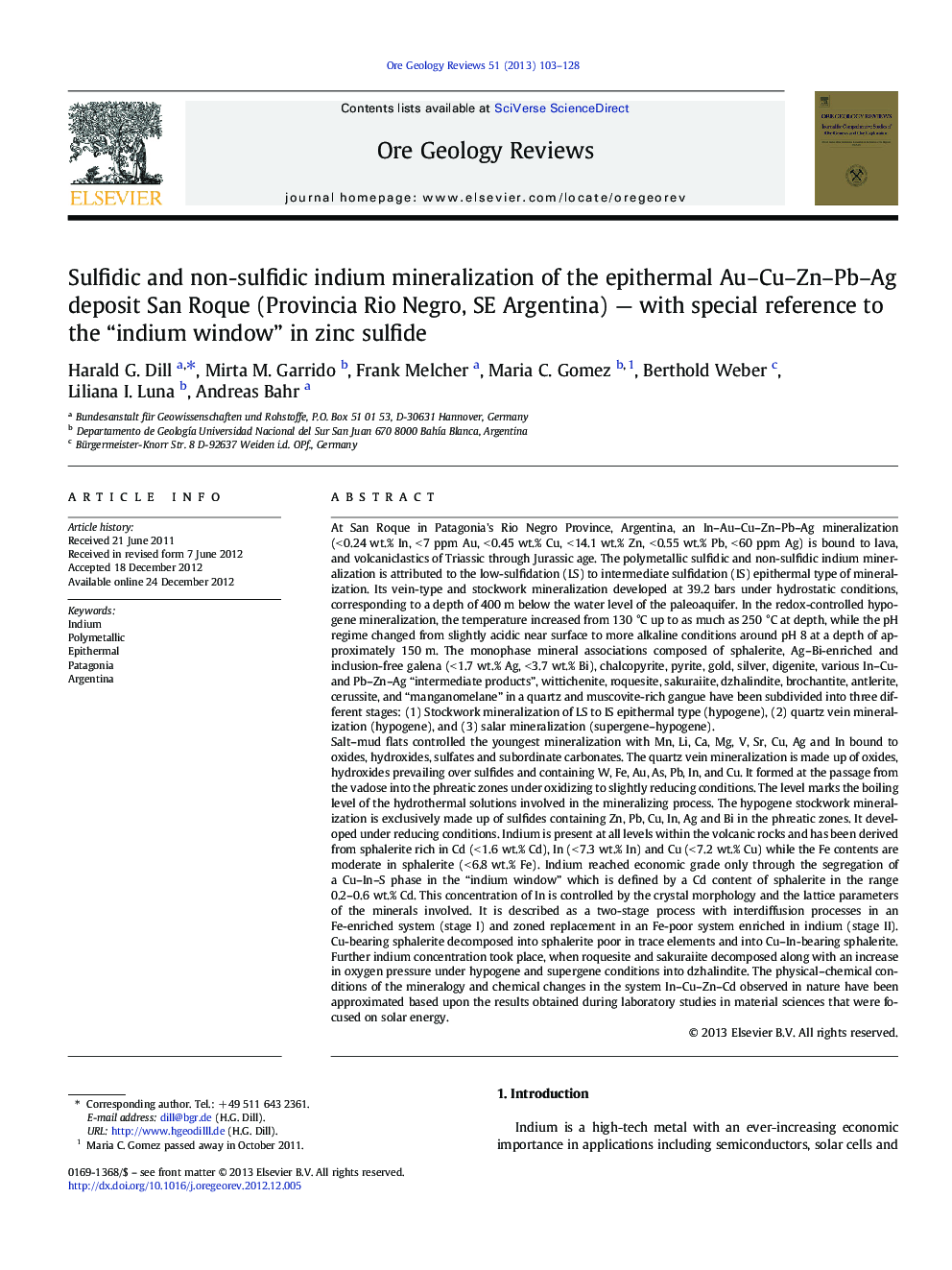| کد مقاله | کد نشریه | سال انتشار | مقاله انگلیسی | نسخه تمام متن |
|---|---|---|---|---|
| 4697575 | 1637252 | 2013 | 26 صفحه PDF | دانلود رایگان |

At San Roque in Patagonia's Rio Negro Province, Argentina, an In–Au–Cu–Zn–Pb–Ag mineralization (< 0.24 wt.% In, < 7 ppm Au, < 0.45 wt.% Cu, < 14.1 wt.% Zn, < 0.55 wt.% Pb, < 60 ppm Ag) is bound to lava, and volcaniclastics of Triassic through Jurassic age. The polymetallic sulfidic and non-sulfidic indium mineralization is attributed to the low-sulfidation (LS) to intermediate sulfidation (IS) epithermal type of mineralization. Its vein-type and stockwork mineralization developed at 39.2 bars under hydrostatic conditions, corresponding to a depth of 400 m below the water level of the paleoaquifer. In the redox-controlled hypogene mineralization, the temperature increased from 130 °C up to as much as 250 °C at depth, while the pH regime changed from slightly acidic near surface to more alkaline conditions around pH 8 at a depth of approximately 150 m. The monophase mineral associations composed of sphalerite, Ag–Bi-enriched and inclusion-free galena (< 1.7 wt.% Ag, < 3.7 wt.% Bi), chalcopyrite, pyrite, gold, silver, digenite, various In–Cu- and Pb–Zn–Ag “intermediate products”, wittichenite, roquesite, sakuraiite, dzhalindite, brochantite, antlerite, cerussite, and “manganomelane” in a quartz and muscovite-rich gangue have been subdivided into three different stages: (1) Stockwork mineralization of LS to IS epithermal type (hypogene), (2) quartz vein mineralization (hypogene), and (3) salar mineralization (supergene–hypogene).Salt–mud flats controlled the youngest mineralization with Mn, Li, Ca, Mg, V, Sr, Cu, Ag and In bound to oxides, hydroxides, sulfates and subordinate carbonates. The quartz vein mineralization is made up of oxides, hydroxides prevailing over sulfides and containing W, Fe, Au, As, Pb, In, and Cu. It formed at the passage from the vadose into the phreatic zones under oxidizing to slightly reducing conditions. The level marks the boiling level of the hydrothermal solutions involved in the mineralizing process. The hypogene stockwork mineralization is exclusively made up of sulfides containing Zn, Pb, Cu, In, Ag and Bi in the phreatic zones. It developed under reducing conditions. Indium is present at all levels within the volcanic rocks and has been derived from sphalerite rich in Cd (< 1.6 wt.% Cd), In (< 7.3 wt.% In) and Cu (< 7.2 wt.% Cu) while the Fe contents are moderate in sphalerite (< 6.8 wt.% Fe). Indium reached economic grade only through the segregation of a Cu–In–S phase in the “indium window” which is defined by a Cd content of sphalerite in the range 0.2–0.6 wt.% Cd. This concentration of In is controlled by the crystal morphology and the lattice parameters of the minerals involved. It is described as a two-stage process with interdiffusion processes in an Fe-enriched system (stage I) and zoned replacement in an Fe-poor system enriched in indium (stage II). Cu-bearing sphalerite decomposed into sphalerite poor in trace elements and into Cu–In-bearing sphalerite. Further indium concentration took place, when roquesite and sakuraiite decomposed along with an increase in oxygen pressure under hypogene and supergene conditions into dzhalindite. The physical–chemical conditions of the mineralogy and chemical changes in the system In–Cu–Zn–Cd observed in nature have been approximated based upon the results obtained during laboratory studies in material sciences that were focused on solar energy.
Journal: Ore Geology Reviews - Volume 51, June 2013, Pages 103–128